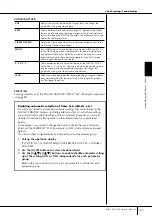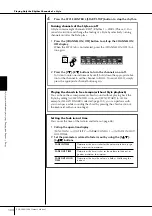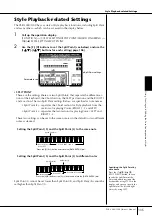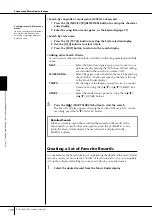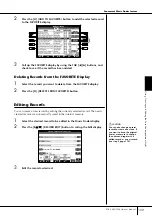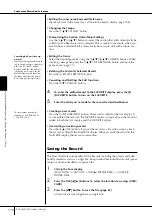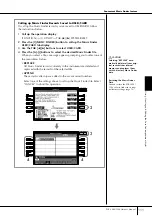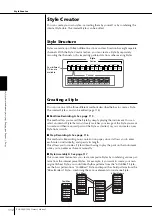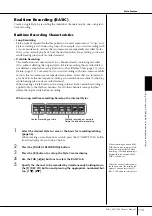
Style Creator
PSR-3000/1500 Owner’s Manual
115
Using, Creating and Editing the
A
uto
Accompaniment Styles
10
Use the [5
π
π
π
π†
†
†
†
]/[6
π
π
π
π†
†
†
†
] buttons to determine the length (number of
measures) of the selected section.
Actually enter the specified length for the selected section by pressing the
[D] (EXECUTE) button.
11
Start recording by pressing the Style Control [START/STOP] button.
Playback of the specified section starts. Since the accompaniment pattern
plays back repeatedly in a loop, you can record individual sounds one by
one, listening to the previous sounds as they play. For information on
recording to channels other than the rhythm channels (RHY1, 2), refer to the
section “Rules when recording non-rhythm channels” (see below).
12
To continue recording with another channel, simultaneously hold
down the [F] (REC CH) button and press the appropriate [1
†
†
†
†
]–[8
†
†
†
†
]
button to specify the channel, then play the keyboard.
13
Stop recording by pressing the Style Control [START/STOP] button.
14
Press the [I] (SAVE) button to call up the Style Selection display to
save your data.
Save the data in the Style Selection display (page 67).
Deleting the recorded rhythm
channel (RHY 1, 2)
To delete a specific instrument
sound, simultaneously hold
down the [E] (RHY CLEAR) but-
ton (from the display where the
recorded channels are shown)
and press the appropriate key.
CAUTION
The recorded Style will be lost
if you change to another Style
or you turn the power off
without executing the Save
operation (page 67).
Any desired chord or chord pro-
gression can be used for the
INTRO and ENDING sections.
Changing the Source Chord
If you want to record the pattern
with a Source Chord other than
CM7, set the PLAY ROOT and
PLAY CHORD parameters on the
PARAMETER page (page 122)
before recording.
Rules when recording non-rhythm channels
• Use only the CM7 scale tones when recording the BASS and PHRASE
channels (i.e., C, D, E, G, A, and B).
• Use only the chord tones when recording the CHORD and PAD chan-
nels (i.e., C, E, G, and B).
Using the data recorded here, the auto accompaniment (Style playback) is
appropriately converted depending on the chord changes you make dur-
ing your performance. The chord which forms the basis for this note con-
version is called the Source Chord, and is set by default to CM7 (as in the
example illustration above). You can change the Source Chord (its root and
type) from the PARAMETER display on page 122. Keep in mind that when
you change the Source Chord from the default CM7 to another chord, the
chord notes and recommended notes will also change. For details on
chord notes and recommended notes, see page 123.
C R C
C R C
C = Chord notes
C, R = Recommended notes

